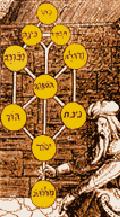
|
|
The Sefirot The symbol of the Sefirot is the defining notion of Kabbalistic theosophy. The Sefirot (singular Sefirah) which are almost always conceived to be ten in number, are the building blocks of creation, the archetypes of existence, the traits of God, and the primary values of the world. The earliest reference to the Sefirot is in the proto-Kabbalistic source, Sefer Yetzirah (The Book of Formation), where the ten Sefirot and the twenty letters of the Hebrew alphabet are together said to comprise the "thirty-two wondrous paths of wisdom" through which God "engraved and created the world". Subsequently, the Sefirot symbolism became a predominant theme in Sefer ha-Bahir, the Zohar, and all later Kabbalistic texts. The word "sefirah" literally means "counting," but a
number of other etymological connections are evident in Sefer
Yetzirah and in the early Kabbalah.
These include the words sepher (text), sepharim (books), sippur
(communication), and sappir (sapphire,
brilliance, luminary), separ (boundary) and safra (scribe) which considerably By the time of Sefer Ha Bahir (late twelfth century), the Sefirot were no longer regarded as numbers, but were understood in Gnostic or Neoplatonic terms as aeons or logoi, which serve as the instruments of creation. Sefer ha-Bahir identifies the Sefirot with the mašamoroth (the ten words or sayings by which the world was created, and with middoth (Godšs attributes or traits). In doing so the Bahir establishes a link between the Sefirot and certain talmudic ideas. For example, we read in the Talmud that the world was created through ten things: "by wisdom and by understanding, and by reason and by strength (Gevurah), by rebuke and by might, by righteousness and by judgment, by loving kindness and compassion" (Talmud, Tractata Hagiga 12a). The connection with this and other talmudic, aggadic, and biblical passages (Chronicles 29:11) suggests that the Sefirot are a hypostatization of these earlier Jewish ideas. The question of whether the Sefirot are one with Ein-sof or are emanated as independent entities is left somewhat ambiguous in most of the Kabbalistic sources. Azriel, and later the Zohar, speak of them as being one with Ein-sof, in the sense that the flame, the sparks, and the aura are one with the fire. According to Azriel the Sefirot, like Ein-sof itself, have the dialectical character of being "the synthesis of everything and its opposite," a synthesis which is the source of all energy in everything whatsoever. Both the Zohar and Joseph Gikatilla equate each Sefirah with a biblical name of God, suggesting that if they are not to be completely identified with the deity they are, at the very least, his aspects or powers. The Zohar uses a variety of terms amongst which are levels", "powers", "firmaments", "worlds", "pillars", "lights", "colors", "dates", "gates", "streams", "garments", and "crowns" to refer to the Sefirot. The Zohar conceptualizes the Sefirot as dimensions, archetypes, spiritual forces, activities within the Godhead, gates to the divine world, aspects of God and ways in which God is manifest in creation. The Sefirot symbolism implies that God, the cosmos, the human soul, and the act of knowledge are all a single, unified essence or substance. Amongst the Lurianists we find the idea that the initial results of Ein-sofs "turning inward" via the Tzimtzum produces a differentiation of divine middot or traits within the godhead. The progressive differentiation of these divine traits give rise to the ten Sefirot which are ultimately emanated as receptacles (Kelim) for the divine light emanated into the lower worlds. Further, Luria postulated that the Sefirot undergo dynamic transformations as a result of dramatic events that occur both within the godhead and in the created worlds. Amongst these are the "Catharsis of Din" and the "Breaking of the Vessels." The Sefirot number ten, but they were subject to a variety of appellations. Isaac the Blind named six of the Sefirot directly for the praises of God enumerated in Chronicles 29:11:
These Sefirot were, however, renamed by later Kabbalists, resulting in a system in which there are often several names for each Sefirah. Keter (Crown), for example, is also referred to as Ayin (Nothingness), Ratzon (Will), Atika Kaddisha (the Holy Ancient One), and Ehyeh ("I will be"). However, a fairly uniform scheme was adopted in the later Kabbalah, one that accords with the order of the Sefirot as given by Moses Cordovero. This scheme (along with the most common alternative appellations and the corresponding names of God) is outlined below: Order of the Sefirot 1. Keter Elyon (Supreme Crown) or Ratzon (Will) 2. Chochmah (Wisdom) 3. Binah (Intelligence) or Gedulah (Greatness) 4. Chesed (Love) 5. Gevurah (Power) or Din (Judgment) 6. Tiferet (Beauty) or Rachamim (Compassion) 7. Netzach (Lasting Endurance) 8. Hod (Majesty) 9. Yesod Olam (Foundation of the World) or Tzaddik (Righteous One) 10. Malchut (Kingdom) or Atarah (Diadem), or Shekhina (Feminine divine presence)
|
 broaden the
terms connotative significance (
broaden the
terms connotative significance (